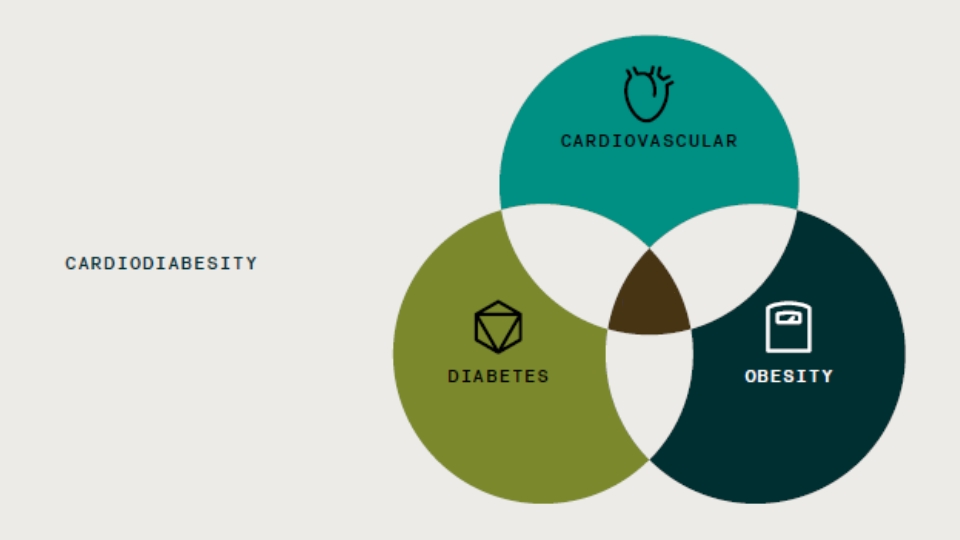Diabetes, obesity, and cardiovascular disease are among the biggest health problems in the United States. In fact, 50% of U.S. adults are projected to be obese by 2030 and the number of people with diabetes will increase by 39.3% by 2060. Both conditions are key risk factors for cardiovascular disease, which remains the No. 1 cause of death in the U.S.
The term “cardiodiabesity” defines and describes the interrelationship between type 2 diabetes, obesity, and cardiovascular disease. Research estimates the combined cost of these three conditions is $838 billion annually.1

“The expected increases in the prevalence of diabetes, obesity, and cardiovascular disease will unfortunately mean more patients with severe complications such as stroke and disability, and more deaths,” said Dr. Calie Santana, senior medical principal at Evernorth. “Most of the risk comes from cardiovascular complications and not from diabetes or obesity alone but these complications can be prevented.”
The Evernorth Research Institute analyzed aggregated and anonymized data of almost 5 million insured individuals from all demographic and socioeconomic groups throughout the United States between 2019 and 2022 (across three lenses: prevention, diagnosis and complications). We found that 1.1% of our sample (approximately 36,000 people) had early stage cardiodiabesity and 0.7% (approximately 11,000 people) had a more advanced state of cardiodiabesity. (Get the full report here)
“The hope is to better understand, develop, and tailor health-improving as well as value-creating intervention strategies for each phase of the condition,” said Urvashi Patel, Ph.D., vice president of the Evernorth Research Institute.
Here are the top three findings from our analysis.
1. Evidence-based prevention can stop the progression
According to the research, the top priority from a cardiodiabesity standpoint is prevention. People with risk factors such as hypertension, prediabetes, and high cholesterol need early intervention to manage these conditions — before they develop cardiodiabesity.
“We can improve health outcomes by identifying at-risk patients early enough and acting with urgency to reduce their progression to worse health. We must work with the patient, their caretakers, and clinicians to apply the best evidence we have on how to control blood pressure, sugar and cholesterol in order to save patients from future suffering and disability. This will also save employers and our health care system considerable costs,” Dr. Santana said, pointing to incentives for patients and clinicians as one way to encourage prevention and risk factor control.

Click here to view a larger version of this map in a new window/tab.
2. Cardiodiabesity is a progressive disease
While diabetes, obesity, and cardiovascular disease each can cause health issues on their own, the combination of all three increases the chances for more severe problems. Our analysis found staggering rates of progression: 27.4% of patients with risk factors for cardiodiabesity and 88.4% of patients in the active cardiodiabesity state saw their health worsen within one year.
“Raising awareness and drawing attention to the risk factors of cardiodiabesity is the first step to prevention,” said Patel.
3. Disease burden and progression varies by sociodemographic group
In our analysis, the highest prevalence of cardiodiabesity was among people older than 50, indicating age plays a big factor. Our analysis also found that both the prevalence of cardiodiabesity and the progression from risk factors to cardiodiabesity was highest among those living in areas with very high social needs of the U.S.
Interestingly, early stage cardiodiabesity is more prevalent in women, while the active cardiodiabesity state and the risk of progression are more prevalent in men. Our analysis cannot ascertain whether these differences are biological or due to diagnostic delays or a combination.
“These findings indicate that, in order to achieve equitable health, our clinical and population health interventions to prevent and manage cardiodiabesity must address head-on the specific needs and barriers to care of different affected segments within the patient population,” Dr. Santana said.
Originally published on 9/7/2023 and updated on 11/25/2024.
This report is the first of a two part-series on cardiodiabesity. Our next iteration dives deeper into the costs associated with cardiodiabesity and launched in late Fall 2023.



